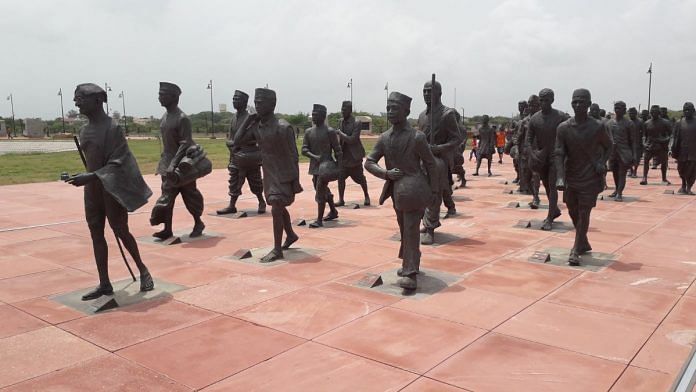We shelter the worst of the afternoon heat at this little establishment, and then start walking into Vejalpore, seeking the Wadi. Some confusion ensues, but the guard at Gandhi Farm tells us where to look, and we trace it down to a spot on top of which today stands a huge Swaminarayan temple. A local trader who has a little laundry in line with the temple tells me he cannot be certain, but believes that the temple is at least a decade old. This is the second Gandhi site of the day upon which all we’ve been able to map is absence.
Next, we look for the Mill, which had once belonged to ‘active Congress worker Manilal Teli’ (Weber 2009: 367). People seem to know something about it that we don’t: we get directions which place us behind it, but then a woman who runs a little flour mill in the same lane tells me, ‘Naina battery mate pucho—tamne madi jashe—tya aj mill che’ (Ask for Naina Battery: you’ll find it—that’s where the Mill is). This, we find. I’m chatting with the foreman of the establishment, asking whether the mill still exists, and whether the house behind it in the field where Gandhi is meant to have rested the afternoon he spent in Vejalpore is still around. I tell him what we’re doing—pulling out my, by now, fairly rehearsed answer: ‘Namaste sahib, maru naam Harmony che, hun Ahmedabad thee chu, ane ame Dandi thee Ahmedabad chaltachalta jai rahya chiye.’ (Hello: my name is Harmony, I’m from Ahmedabad, and we are walking back there from Dandi.)
The foreman tells me how the Municipal Corporation has harassed them before: they broke down part of the perimeter wall of this property for ‘road-widening’ recently. I’d been warned in Dandi that people would not own up to Gandhi’s presence along the route because doing so would complicate things for them. The Government could lay claim to their property in the name of ‘developing’ it as a ‘heritage’ site, and they feared having to leave, or receiving inadequate compensation. For this last, I had no sympathy at this point, but like so many easy assumptions, the road and life on it forced a sharp rethink or, at least a softening of stance soon enough. No binaries here after all: they would feel out of place when one is engaging with a man who knew how to leverage them as a communication strategy, but lived his life more keenly aware of context and the need to adapt to it than most.
Also Read: ‘Plane broke into three pieces’: Hardit Singh’s first flight over German lines in Droglandt
Just then, a surly man with a leonine mane looked out from the second floor of the residential building in front of what must have—could only have—been the Mill. He said ‘tamari bhul tahi che—Gandhi ahiya rokayla aj nahi’. (You’re mistaken: Gandhi did not stop here at all.) I told him I knew this was untrue; that we were retracing the journey, and wanted only to see the spot he rested at. He went to ask, I think, the owner of the building something: came back and said that the owner had told him to tell us that she wanted us to leave immediately. The foreman and other workers there told me the room out back was ‘broken’. I don’t believe it, but there’s nothing we could have done at this point. Naina Battery. Teliya Mill. It is what it is.
The bulk of the day’s walking is now behind us, and it has been hot overhead, so we take a much needed breather at a small establishment just as we hit Navsari. Finally, as evening falls, we walk to Dudhiya Talav, looking for the ‘Ghanchi ni Wadi’ dharamsala which had served as Gandhi’s rest stop. We don’t spot it, so ask a local business owner, who calls someone he thinks may know the answer to our question: it turns out to be a local (Congress) councillor. He arrives shortly, and escorts us to a building with a plaque on it, albeit buried under scores of flyers and other advertisements. It is a community hall still; just in a shopping centre called ‘Gandhi Market’. He talks to us for a time, having rounded up someone to clear the pasted flyers off the plaque demarcating that this was, indeed, the spot where Gandhi and the Marchers spent their penultimate night on the road. He seemed apologetic about the state of the plaque, but told us we could count on him for any help we may require while we were in Navsari or around it.
Kalubhai has arranged for us to spend the night at Mamta Mandir, and we see him there for dinner later that evening: he’s been wonderful to us. Such an inspiration, even though there’s something that discomfits me about his role as a mediator and interpreter between people and government. It is, by all accounts, excellent work he does from the sound of it, since he communicates to the people in Dandi precisely what they can claim from the government’s many welfare schemes, and how. But government can only be ‘mediated’ this much and no further, I catch myself thinking.
Also Read: Agyeya wanted to publish a Nehru-at-60 journal. Indian and global writers told him this
Gandhi in Vejalpore–Matwad
After a short walk out of Navsari, along the railway line for a part of the way, Gandhi and the Marchers reached the home of Congress worker Manilal Teli in Vejalpore on the morning of 4 April 1930. After resting for a time, Gandhi walked to the nearby Prajapati ni Wadi, where at 3:30 p.m., he addressed a large crowd that, Weber writes, ‘had been waiting patiently for hours’ (2009: 367) to hear him give one of his final speeches before Dandi. In this speech, Gandhi spoke about how the resignations of village headmen and other local functionaries would cause the British administration to fairly collapse upon itself: ‘an enumeration of the Headmen and Talatis in the seven lakh villages of this country would give us fourteen lakhs of such legs and in this manner the resignation of each Headman would amount to the loss of one leg. It is for this reason that these resignations have value. This is so, however, only if they have been tendered sincerely… If they want to be loyal to Sardar (Patel) they will have to be disloyal to the Government’ (CWMG 43 1967: 178) he tells the assembly, playing upon the region’s fondness for Patel, who had had an important role to play in mobilizing people and driving the Bardoli Satyagraha of 1928.
Vejalpore is also where Gandhi seems to have become cognizant of the limitations that would have to be borne in mind with regard to the choice of Dandi as the spot where this Satyagraha would commence: ‘I am going to Dandi. But I would request you not to follow me there. If you do, come as soldiers carrying your food on one shoulder and water on the other. Come with the intention of doing some work. Do not come with the idea of having a picnic’ (CWMG 43 1967: 178) he warned the crowd, mindful of the fact that there was neither any spare accommodation nor any arrangement for food or water which could have been made in the event of huge numbers turning up in this out-of-the-way little seaside village which was his final destination.

Harmony Siganporia teaches Culture & Communication at MICA, Ahmedabad
This excerpt from ‘Walking from Dandi: In Search of Vikas’ by Harmony Siganporia has been published with the permission of Oxford University Press.



